For everyone’s safety:“always bathe at the same time as your children“
Swann, sports coach for the first swim training network Swim Stars, takes the time to answer questions and remind us of an important safety rule for everyone.
Before Swim Stars
I worked at Club Med as a lifeguard, then I stopped to move to Paris. Today, I work in a private pool in Versailles.
During Swim Stars
I came to Molitor to give lessons in the pool of the 5 star hotel. Then I was also a coach at the Villa Saint-Charles to teach Auto-Rescue classes. Finally, I supervised courses in Montparnasse, at the Stanislas College, in a beautiful 25 meter pool.
Safe in the water
It’s fun, but we don’t forget to work! It’s true that I’m a gambler and quite close to the children.
Your favorite sin
I love junk food, candy like the kids, and also baked goods, especially apple pie!
What safety advice would you give to parents?

To avoid drowning: “always swim with your children”.
Thanks for your safety tip Swann! Thanks to you, our little fish will always be safe!
But why is it important to remember this? Because parents can sometimes be lax in their vigilance.
At the approach of the summer, the government had communicated the following message “you hold with them, do not leave them of the eyes”.
France Bleu had listed the good reflexes during the summer 2020
Every year, there are more than 1000 accidental drownings in children under 25 years old.
Every summer, accidental drownings cause about 50 deaths among children under 13 years old. A lack of supervision is noted in one out of two drownings (source: Ministry).
Find more tips with our coach Émilie!
https://blog.swimstars.fr/pedagogie-coach-swim-stars-portrait-emilie/
https://blog.swimstars.fr/coach-apprendre-a-nager/
AUTO-RESCUE®: Femme Actuelle Le Mag recommends 5 tips for safe swimming
AUTO-RESCUE®, Femme actuelle magazine recommends swimming lessons starting at age 3. This is the occasion of an article that gathers the 5 best tips for a safe swimming. In addition, we find a testimony of Joëlle Pulinx Challet, general delegate of the Fédération professionnelle de la Piscine (FPP), who speaks on this subject.
Every year, when the weather is good, there are many cases of children drowning. Therefore, to enjoy swimming in peace and avoid accidents, follow the advice!
Find the 5 tips for safe swimming with the AUTO-RESCUE® courses
1/ Promote children’s autonomy
Specialist Joëlle Pulinx Challet points out, “the earlier children learn to swim, the lower the risk of drowning.” As the newspaper Femme Actuelle writes, the AUTO-RESCUE® program allows children to learn survival reflexes in case of a fall in water. In other words, the course promotes the child’s autonomy and helps prevent the risk of drowning.
“One of the best ways to prevent the risk of drowning is to make children self-sufficient in the pool.”
2/ Redouble your vigilance
Always have a trusted adult supervise your child in the water. Our Swim Stars coaches keep telling our students this every day, just like Swann.
This is also an important tip that our mascot Poulpy gives to school children during our
our drowning prevention (SAFE).
Why? For the drowning is silent. And in the water, a vigilant adult can quickly intervene! Indeed, the awareness of children and parents to the risks of drowning is essential here.

And he is Poulpy, a specialist in drowning prevention (SAFE) who masters the AUTO-RESCUE®.
3/ Multiply the protection systems
A locked gate around the pool to prevent access is required. But this security is not infallible, hence the need to double the protection systems with an alarm. If you have an above ground pool, remove the ladder or block the access steps.
In our drowning prevention program (SAFE)
program, the mascot Poulpy is featured in the first image to talk about safety. Despite the closure, Poulpy breaks through the barrier into the pool and falls into the water. The alarm did not sound but Poulpy is autonomous thanks to
learning the starfish, the safety position. Finally, the best protection is learning the life-saving gestures.
4/ Use the protection systems properly
Protection systems such as automatic covers exist to cover the pool and prevent swimming. The general delegate, Joëlle Pulinx Challet, reminds us that it must be used between each swimming time and not only at the end of the day.
5/ Beware of certain inflatable products
Crocodile mattresses, unicorn buoys and inflatable dolphins allow you to float, but the risk of flipping over is far too dangerous. Like the bouncy ball, any object that is not removed from the pool after swimming becomes a temptation for the child. Most drownings are the result of an accidental
accidental fall into water
Most drownings are the result of an accidental fall into water, usually in private, unsupervised pools.
By adopting good reflexes, accidents can be avoided.
This is what our Poulpy says when he saved his sister from drowning
because she wanted to get the ball in the pool.
Should we be wary of armbands?
Armbands are inflatable objects that allow a child who cannot swim to float in the water. But it never replaces supervision. On the other hand, the safety of the armbands is not infallible because a child can lose one out of two or both by accident. This can be the case after jumping into the water with both arms raised or because they can puncture and deflate.
Do we bring the armbands back to swim class from age 3?
During the SELF-RESCUE® course, children cannot learn to swim with the armbands. We recommend the use of the French fries we provide during our classes, so that our little fish learn to move freely with their arms and legs. The armbands cause the child to be in an upright position, while the fries allow the child to adopt a horizontal position, which is essential for learning.

The AUTO-RESCUE® program teaches children how to get to the poolside easily with simple actions
The complete article is available
by here
and all our other reports are available here!
Drowning: how to be S.A.F.E.?
To prevent swimming hazards, the Swim Stars S.A.F.E. program informs you of simple actions you can take to save lives by avoiding drowning.
In English, the word “SAFE” means to be safe or out of danger. Each letter corresponds to a French word and announces the themes. Indeed, it is the acronym for Safety, Learning, Training and Environment. These 4 themes are the subject of a playful presentation in schools with the mascot Poulpy! It’s a little octopus that schoolchildren must keep safe through the adventures of the cephalopod.
Avoid drowning with our 8 tips to be S.A.F.E
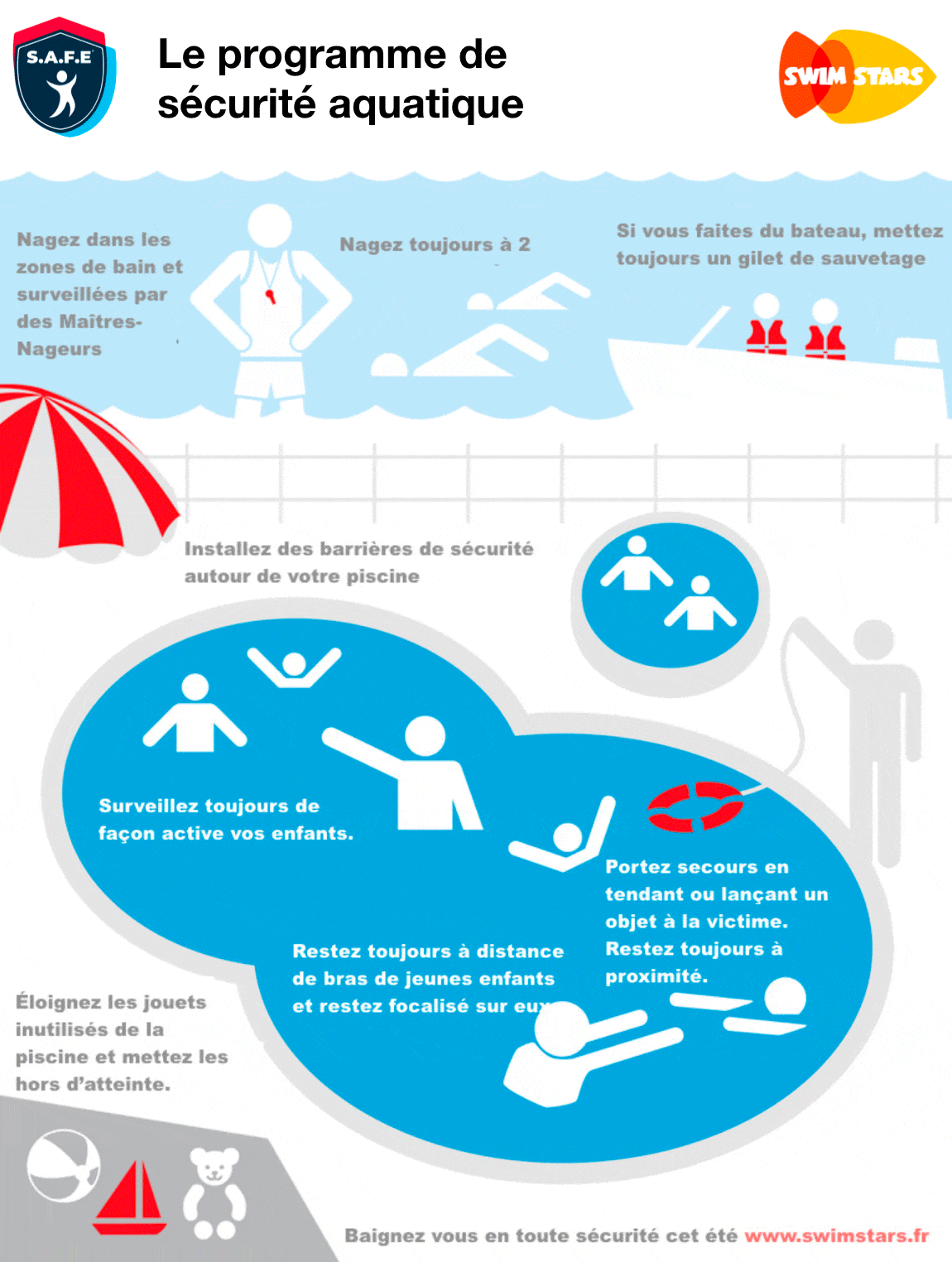
8 anti-drowning tips by S.A.F.E
Drownings: prevention rather than cure!
First of all, it is necessary to make sure of its level of practice. How do I evaluate my swimming level?
Once you are aware of your relationship with water, you can evolve serenely.
So, learning to swim with a lifeguard at a young age will give you all the tools you need to prevent drowning as an adult.
earing to swim with a lifeguard at an early age will give you all the tools you need to prevent drowning as an adult.
When a child is swimming, it is imperative that a trusted adult be in the water at the same time and nearby to supervise the child. Because when the adult is watching out of the water, vigilance can decrease because of many temptations. In fact, consulting the cell phone or taking a nap are the first two causes of a slackening.
The child is moving and may not be in your field of vision. This is where the danger begins.
Prevent swimming accidents such as trauma
For children, as well as adults, always check the depth of the swimming area (pool, lake, river, and sea) before jumping into the water. Indeed, a bad reception can lead to a shock that can endanger your back (compression of the dorsal discs, risk of paralysis) and cause a suspicion of spinal trauma (cervical level).
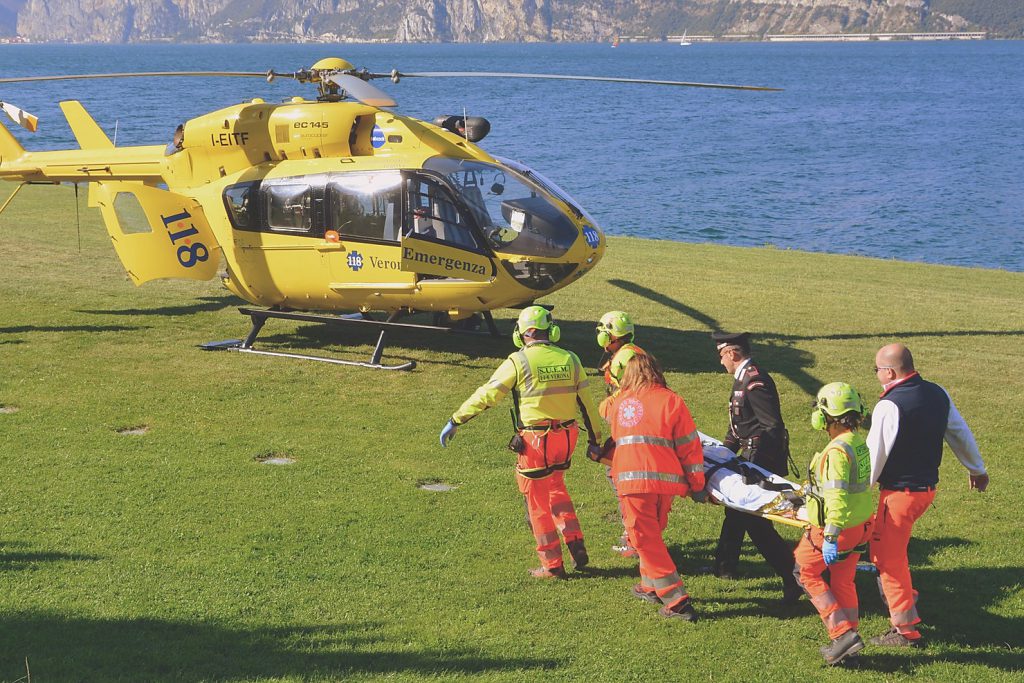
Drowning: intervention on a suspicion of trauma following a dangerous dive in a swimming area with little depth
Drowning by hydrocution: what simple reflexes should you adopt to preserve your health?
Before each swim, you should enter the water gradually.
Why? Wetting the back of the neck is an essential gesture to prevent the risk of hydrocution. In fact, during hot weather, a thermal shock between the outside temperature, the water temperature and your body temperature can cause a cardiac arrest.
Eating a large meal, drinking alcohol or cold drinks before or during swimming are aggravating risk factors. The risk of discomfort will be increased if the water is cold or after long exposure to the sun. In case of shivering, it is strongly advised not to swim in order to avoid any risk of distress in the water. Otherwise, if you decide to go swimming as a responsible adult, always tell someone close to you first.
Drowning: why choose supervised swimming areas?
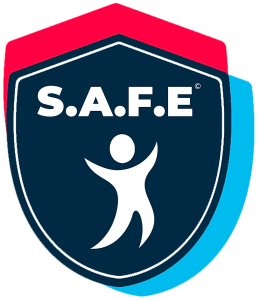
Drowning: S.A.F.E. logo for drowning prevention program
Because in the event of a swimming accident, first aid professionals are already on site to provide rapid care.
Find out if the swimming areas are supervised. Very often signs indicate whether the bathing area is supervised or not. If necessary, contact the town hall on which the beach in question is located.
In France, it is forbidden to swim in certain rivers. It is often forbidden to swim there because of the strong currents, as in the Loire for example, and the high pollution. Swimming is rarely supervised in rivers.
- Choose supervised areas for swimming
- Be aware of children even in supervised areas
- Find out about swimming conditions: currents, natural hazards, etc.
- Always follow the safety instructions indicated by the swimming flags and/or the lifeguards.
- If necessary, go to the first aid station to obtain additional information.
Drowning: how to react in case of difficulties in the ocean?
The S.A.F.E. program provides advice on how to react in case of difficulties at sea.
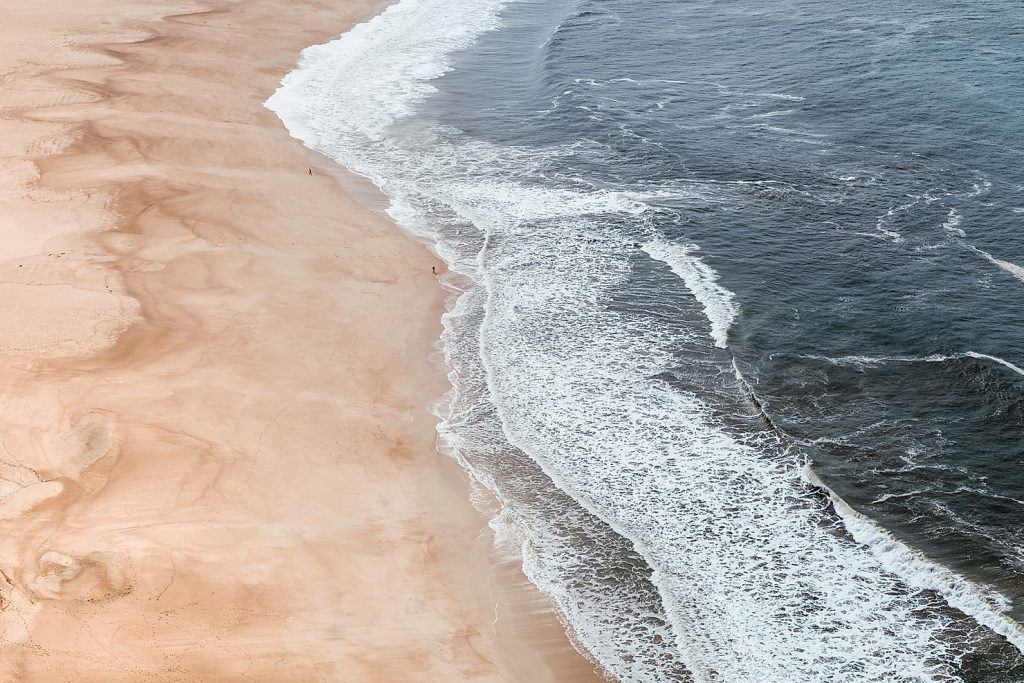
Drownings: Avoiding difficulties at the ocean
Drowning: 5 tips for the right reaction
- Do not panic
- Do not try to fight against the current, the waves and the rollers, so as not to exhaust yourself. Indeed, it is better to let yourself be guided to keep your strength
- Let yourself be carried by the current and use your arms to call for help
- Do the plank in case of fatigue. This allows you to breathe normally
- Try to stay calm until help arrives.
And if one day you witnessed a drowning: what to do?
S.A.F.E. gives you its advice on how to react if you witness a drowning.
Witnessing drownings: our 3 tips
- Notify the lifeguards immediately if the area is supervised. Then call for help by dialing 15 or 112 if it is an unattended area
- Do not take your eyes off the victim in order to guide the rescue team
- Do not intervene directly unless the witness feels able to help without risking his or her own life. Caution: This implies a very good physical condition and very good swimming skills (you must be able to pull the victim in the water). In fact, it is common for people who have tried to help to end up drowning themselves.
Therefore, do not feel guilty if you have not dived yourself. It is by preventing and alerting that you will save the life of the person in distress.
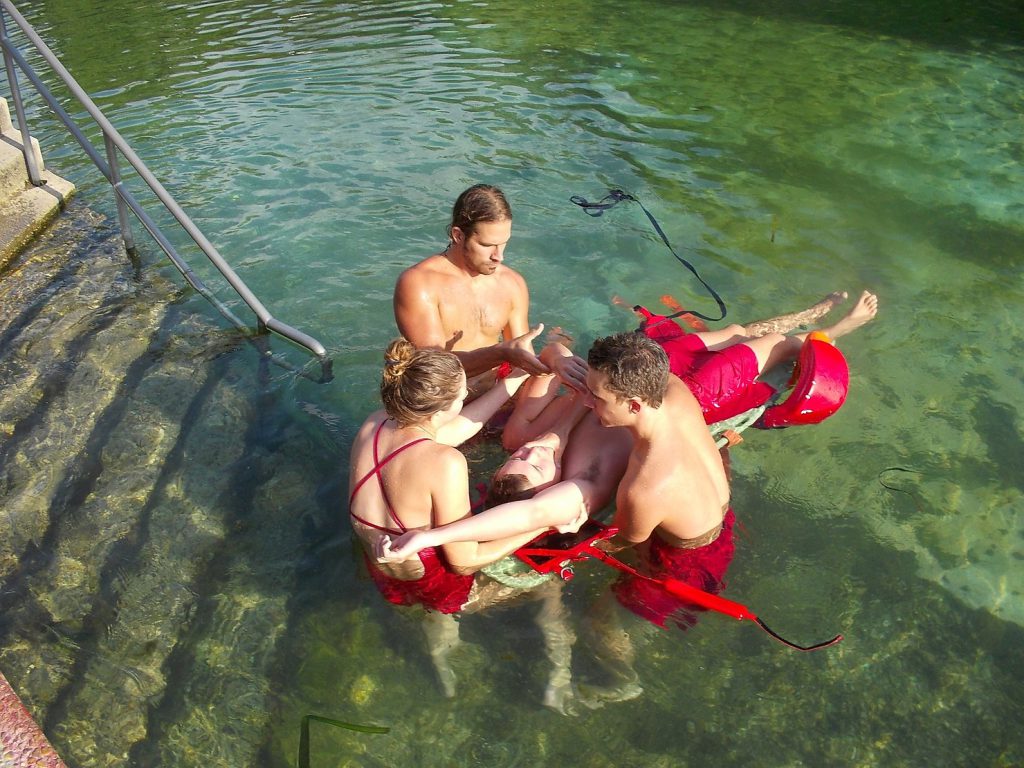
Drowning: victim rescued during a response exercise.
https://blog.swimstars.fr/securite-aquatique-programme-safe/
https://blog.swimstars.fr/journee-mondiale-securite-aquatique/









